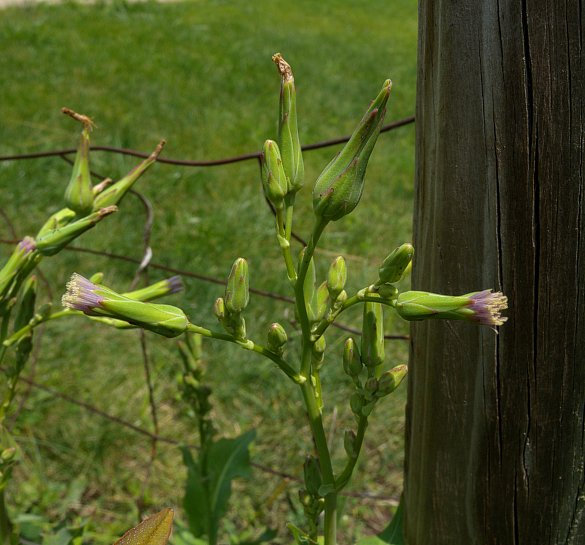
The upper surface of both basal and alternate leaves is yellowish green to medium green, glabrous and sometimes glaucous, while their lower surface is light green, glabrous, and sometimes glaucous. In addition, abundant prickles occur along the central vein of the lower leaf surface, while sparse prickles sometimes occur along the major lateral veins. The bases of alternate leaves clasp their stems with short rounded auricles (ear-like basal lobes) that are dentate-prickly and occasionally sinuous. The tips of these leaves are bluntly angled to acute. Both the stems and leaves of this plant contain a brown latex. The central stem and sometimes upper lateral stems terminate in panicles of flowerheads; these panicles are variable in size, but on larger plants they become up to 1½' long and 1' across. The branches of each inflorescence are more slender than the stems, otherwise they share similar characteristics. Small bractlets occur where these branches divide. The flowerheads often fail to open, but they are self-fertile. Those flowerheads that do open (on bright sunny days during the morning), can vary considerably in size, depending on the local ecotype; their diameter varies from 4-6 mm. in some areas to 12-18 mm. in other areas. Each flowerhead has 20-55 widely spreading ray florets and no disk florets. The petaloid rays of the flowerhead are narrowly oblong in shape; their tips are truncate and 5-toothed. The petaloid rays are usually light blue, but sometimes they are white to yellow. The tips of the petaloid rays, where the teeth occur, are often pale bronze.
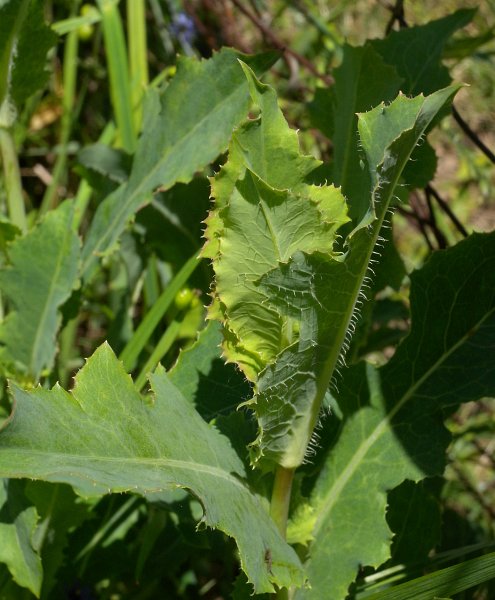
The bases of flowerheads (involucres) are up to 15-20 mm. long and cylindrical-lanceoloid to lanceoloid in shape; they achieve their maximum size shortly after blooming. Around the base of each flowerhead, the floral bracts (involucral bracts) are arranged in several series; inner floral bracts are longer than outer floral bracts. They are linear-lanceolate in shape (upper-inner bracts) to ovate in shape (lower-outer bracts) and appressed together; these bracts are light green with white to purplish red margins, and they are glabrous. The blooming period occurs during the summer and early autumn, lasting 1½–3 months. Afterwards, the flowerheads are replaced by dense clusters of achenes. Mature achenes are about 4 mm. long, broadly ellipsoid-flattened in shape, and black mottled with brown; each side of an achene has a single central rib (less often 2-3 ribs). At the apex of each achene, there is a white thread-like beak about 4 mm. long, and attached to the apex of this beak is a tuft of white hairs spanning about 15-20 mm. across (individual hairs are 7-10 mm. long). These achenes are distributed by the wind. The root system consists of a taproot. This plant spreads by reseeding itself.
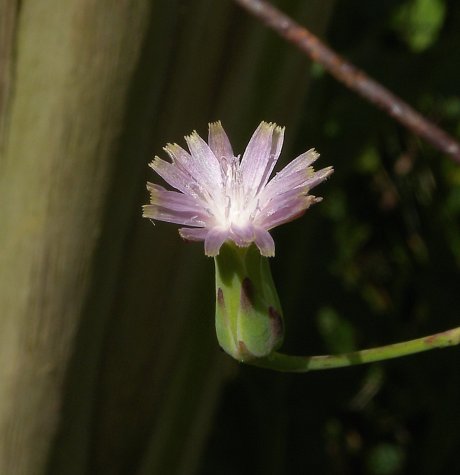
Cultivation: The preference is full sun, mesic to dry conditions, and soil containing sandy loam, loam, clay-loam, or loess. First-year rosettes of basal leaves may die down during winter, but new leaves are regenerated from the taproot during the spring. Open ground with exposed topsoil facilitates germination of the seed. Cultivation of this plant is not difficult, but it is rather weedy-looking and its flowerheads often fail to open.
Range & Habitat: The native Prairie Lettuce is rare in Illinois and state-listed as 'endangered.' It has been found primarily in the northern and west-central sections of the state (see Distribution Map). Illinois lies along the eastern range-limit of this species; it is more common in many areas of central and western United States. Populations of Prairie Lettuce have declined in Illinois, where it is found in such habitats as mesic to dry prairies and hill prairies. Disturbed areas of high quality natural habitats (mainly prairies) are preferred. This wildflower probably benefits from the disturbance provided by occasional wildfires and grazing by American Bison; this animal prefers to graze on grasses rather than forbs.
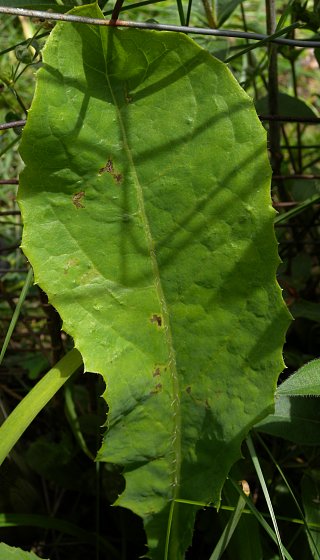
Faunal Associations: Little is known specifically about the relationships of Prairie Lettuce to various fauna. The flowerheads of this plant are probably cross-pollinated by various long-tongued and short-tongued bees. Insects that feed destructively on both cultivated and various species of wild lettuce (Lactuca spp.) consist primarily of aphids and larvae of polyphagous moths. The webmaster observed unidentified blackish aphids feeding on the upper stems and inflorescence branches of Prairie Lettuce. Both White-tailed Deer and the Cottontail Rabbit occasionally browse on the foliage of this plant; the latter animal fed on some of the basal leaves of Prairie Lettuce while it was being cultivated in a garden by the webmaster.
Photographic Location: The wildflower garden of the webmaster in Urbana, Illinois.
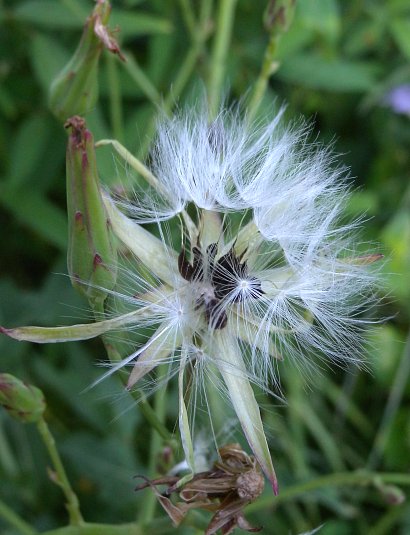
Comments: There are several native and non-native lettuce species (Lactuca spp.) that exist as wildflowers in Illinois. Most of these species are similar in appearance and they can be difficult to distinguish; the presence of both flowerheads and achenes are often required for correct identification. Prairie Lettuce (Lactuca ludoviciana) can be distinguished from many lettuce species by the brown latex of its foliage (rather than white latex). The rays of its flowerheads are often blue, rather than yellow, and the involucres (bract-covered bases) of these flowerheads are usually larger in size (up to 15-20 mm. long). The achenes of Prairie Lettuce have single-ribbed sides (less often 2-3 ribbed) and they have long thread-like beaks that are attached to relatively large tufts of hair (15-20 mm. across). A common Eurasian species, Prickly Lettuce (Lactuca serriola), differs from Prairie Lettuce by having flowerheads with pale yellow rays only (never blue), shorter involucres (up to 10-12 mm. long), and achenes with 5-7 ribs per side, to which are attached smaller tufts of white hair (only 7-10 mm. across).
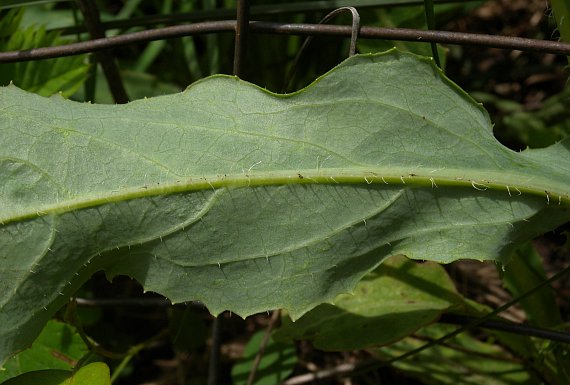
A common native species, Lactuca canadensis (Wild Lettuce), differs by having leaves that lack stiff prickles along their margins, flowerheads with yellow to orange-yellow rays (never blue), shorter involucres (up to 10-15 mm. long), and achenes with smaller tufts of white hair (10-14 mm. across). Another native species, Lactuca biennis (Tall Blue Lettuce), has shorter involucres (up to 8-10 mm. long), achenes with 5-6 ribs per side, very short or no beaks on the achenes, and smaller tufts of hair (10-12 mm. across) that are light brown, rather than white. Another native species, Lactuca florida (Woodland Blue Lettuce), differs by having leaves with triangular-shaped terminal lobes, shorter involucres (up to 10-12 mm. long), achenes with 5-6 ribs per side, very short or no beaks on its achenes, and smaller tufts of white hair (8-10 mm. across). An uncommon native species, Lactuca hirsuta (Hairy Wild Lettuce), differs from Prairie Lettuce by having hairy stems, hairy leaves with ciliate margins, and flowerheads that sometimes have reddish rays, rather than yellow.